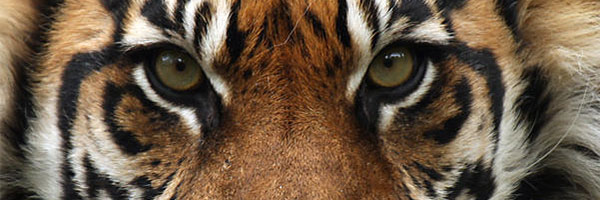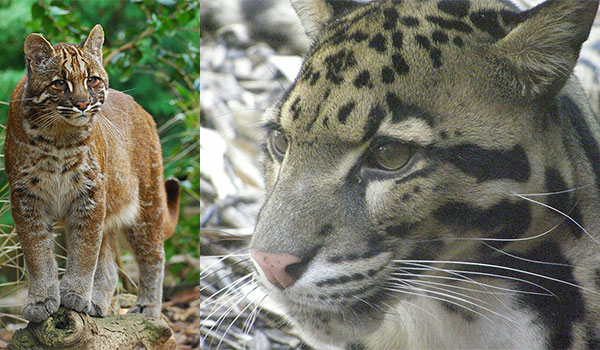Published on October 28, 2013

Endangered tigers, leopards, and other wild cats still roam the remote forests and grasslands of Southeast Asia, though their numbers are dwindling due to the destruction of their habitat and poaching. The chances of spotting one are almost nil, though adventurers willing to head to the hinterlands may find evidence such as paw prints and droppings. However, there is hope, as plenty of wildlife organizations are making a concerted effort to bring the numbers back up.
Sumatra may have ASEAN’s largest variety of big cats with four species. The Sumatran tigeris the best known, though the WWF estimates their numbers are just above 200. Three other tiger sub-species also prowl around Southeast Asia including the Bengal tiger in Myanmar; the Indochinese tiger or Corbett’s tiger in Cambodia, China, Laos, Myanmar, Thailand, and Vietnam; and the Malayan Tiger in the southern Malaysian peninsula.
Tigers are predators and territorial, and the largest, most powerful cat species in the world. Some grow to almost three meters and 300 kg, and are among the highest-jumping mammals in the world. WWF has been working in the 330,000-acre Bukit Tigapuluh National Park, a protected area in the Thirty Hills region of Sumatra to ensure these tigers continue to have room to roam.
Sumatra also plays home to 77 clouded leopards, though the worldwide number is closer to 10,000 when including the populations in Borneo and Mekong region countries. Actually, the clouded leopard is not a leopard at all; in fact, it is not related to any other species in the cat family. Its coat varies from yellow to brown tones with distinctive darker cloud-like markings, The clouded leopard (pictured below right) are relatively small, growing to about one meter and weigh some 20 kg. Sumatra also houses two “real” leopard species, the Indo-Chinese Leopard and Java Leopard, as well as an estimated 70 golden cats and 27 leopard cats.

The Asian golden cat (pictured above left), also called the Temmnick’s golden cat, roams throughout Southeast Asia, with adults growing to 15-kg and a bit more than a meter in length. Its dark brown, gray, or a bright golden red fur, with some spots, is highly prized by poachers, whose job is made easier by the cat’s dwindling habitat of rocky woodlands of deciduous and tropical rain forests. The Asian golden cat preys off of small deer, hares, reptiles, and birds.
The Asian leopard cat covers one of the widest ranges of all Asian wild cats, and inhabits several forested habitats and grasslands throughout Southeast Asia and its islands. The species is rather small at 60 to 90 cm with tails as long as 35 cm. The largest weighs no more than seven 7 kg. Color varies from yellowish-brown in the southern ASEAN countries to grayish-brown in the northern areas of the Mekong region. Their diet consists of small mammals, such as rodents and hares, small reptiles, insects, and fish.
One of the easier civets to spot is the marbled cat in the forests of Cambodia, Laos, Myanmar, and Viet Nam, though the population is fewer that 10,000 and shrinking. About the size of a house cat and a tree dweller, where it hunts birds, squirrels and reptiles, the marbled cat is considered by many as a miniature clouded leopard.
The tiny spotted linsang, a type of civet, survives in the forests of Cambodia, Laos, Myanmar, and Viet Nam, and is known for its short, slender body, and its pointed fox-like head, pointy ears, and small limbs. The cat’s coat on an adult’s 35-cm body tends to be brownish gray with dark patches. The latest population estimate for the spotted linsang is less than 200, making it a very rare civet species.
The unusual and small flat-headed cat, which lives in wetlands, is seen by many as the least-known cat species in the world, and is found in Borneo, Sumatra and the Thai-Malay Peninsula. Living mostly off fish, the flat-headed cat’s numbers have dwindled to fewer than 2,500 due most to its shrinking habitat.
The Bornean bay cat may be the most endangered of all ASEAN felines, and some wildlife experts believe it could soon become extinct. Similar to the flat-headed cat, little is known about the bay cat, which is only found in Borneo. In fact, it was first photographed in 1998. Estimates place its population at 2,500 and shrinking due to for commercial logging and oil palm plantations.
Sources: Earth’s Endangered Species, WWF, and Treehugger.






